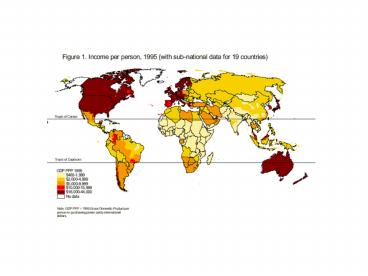Sketch of a modeling framework PowerPoint PPT Presentation
Title: Sketch of a modeling framework
1
(No Transcript)
2
(No Transcript)
3
(No Transcript)
4
(No Transcript)
5
(No Transcript)
6
Sketch of a modeling framework F ? a LF ß
(e A) (1 ß ) (Food production) s
LF / L (Definition
of s) M ? ? LM
(Urban-based manufactures) m M / L ? ?
( 1 s ) (Per capita manufactures) d? / dt
? m (Productivity
growth) n (1/L)dL/dt ? s
(Population growth) Note productivity growth
may allow for diffusion from abroad
7
Assume per capita dietary needs are f and that
beyond dietary needs households have zero income
elasticity of demand for food. Assume also that
we begin in a region in which the basic dietary
needs can be met for the entire population. f
L ? a LF ß (e A) (1 ß ) Thus, s f
(1/ ß) ? (a/ ß) s (1- ß)/ ß where s e
A / L (arable land in efficiency units,
per
capita) (1/ s)(ds/dt) (a/ ß) ? ? (s - 1)
(1- ß)/ ß ? s Depending on initial
conditions, s either approaches 0 (endogenous
growth) or 1 (Malthusian trap)
8
The threshold degree of urbanization is t
a ?? / a ?? (1- ß)? If s gt t
then the economy approaches Malthusian trap If
s lt t then the economy approaches
urban-based endogenous growth Malthusian
trap is likely under the following
conditions Low initial technology level ?
Low land per person (A/L) Low efficiency of
land (e.g. tropical ecozone) e Low urban
efficiency (e.g. landlockedness) ? Low degree
of learning by doing ?
9
The Transition from Adoption (implementation)
to Innovation High concentration of innovators,
few cases of transition to innovation (exceptiona
l cases include Korea, Taiwan, Singapore,
Israel) Special public institutions play a key
role in the transition
PowerShow.com is a leading presentation sharing website. It has millions of presentations already uploaded and available with 1,000s more being uploaded by its users every day. Whatever your area of interest, here you’ll be able to find and view presentations you’ll love and possibly download. And, best of all, it is completely free and easy to use.
You might even have a presentation you’d like to share with others. If so, just upload it to PowerShow.com. We’ll convert it to an HTML5 slideshow that includes all the media types you’ve already added: audio, video, music, pictures, animations and transition effects. Then you can share it with your target audience as well as PowerShow.com’s millions of monthly visitors. And, again, it’s all free.
About the Developers
PowerShow.com is brought to you by CrystalGraphics, the award-winning developer and market-leading publisher of rich-media enhancement products for presentations. Our product offerings include millions of PowerPoint templates, diagrams, animated 3D characters and more.

